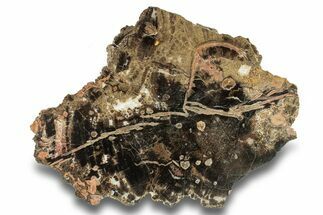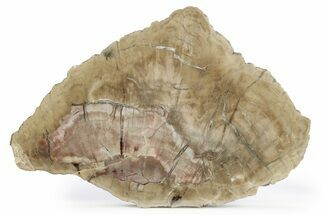This Specimen has been sold.
9.6" Polished Petrified Wood Round with Fungal Rot - Utah
This is a 9.6" wide round of petrified wood (Conifer) from the Triassic-aged Chinle Formation of Utah. The wood contains fossilized fungus (the circular formation). This parasitic fungus grew on the tree while it was still alive and has been named Polyporites wardii. This wood is polished to a glossy finish on one side by one of the best petrified wood polishers in the business.
It comes with an acrylic-metal display stand.
It comes with an acrylic-metal display stand.
What Is Petrified Wood
Petrified wood is the name given to wood that has been turned into stone (fossilized) through the process of permineralization. In this process, all of the organic matter becomes replaced by minerals, while much of the original structure, such as tree rings, is retained. For this to happen, the wood needs to be buried in an environment low in oxygen to prevent decomposition and with flowing, mineral-laden water, so minerals may replace structures. The coloration is caused by various minerals that present in that water during fossilization. For example, red colors are due to iron compounds, greens due to copper, and so on.
Petrified wood is the name given to wood that has been turned into stone (fossilized) through the process of permineralization. In this process, all of the organic matter becomes replaced by minerals, while much of the original structure, such as tree rings, is retained. For this to happen, the wood needs to be buried in an environment low in oxygen to prevent decomposition and with flowing, mineral-laden water, so minerals may replace structures. The coloration is caused by various minerals that present in that water during fossilization. For example, red colors are due to iron compounds, greens due to copper, and so on.
SPECIES
Conifer & Polyporites wardii (Fungus)
LOCATION
Circle Cliffs, Utah
FORMATION
Chinle Formation
SIZE
9.6 x 8", .8" thick
CATEGORY
SUB CATEGORY
ITEM
#274774
We guarantee the authenticity of all of our specimens.
 Reviews
Reviews











